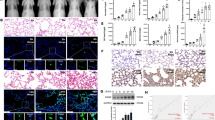Abstract
Alveolar type I epithelial cells (AECIs) play an important role in the pathogenesis of acute lung injury. The receptor for advanced glycation end-products (RAGEs) is expressed at a high basal level in AECIs, and its soluble isoform is suggested as a marker of AECI injury. However, the molecular mechanism by which RAGE mediates inflammatory injury in AECIs remains elusive. In this study, we established lipopolysaccharide (LPS)-induced inflammation in AECIs isolated from neonate rats as the experimental model and investigated the role of RAGE/NF-κB signaling in mediating inflammatory response in AECIs. We found that LPS increased RAGE expression and the secretion of tumor necrosis factor alpha (TNF-α) and interleukin-1 beta (IL-1β) in AECIs in a dose-dependent manner. Knockdown of RAGE significantly decreased TNF-α and IL-1β levels in conditioned medium of AECIs. Electrophoretic mobility shift assay (EMSA) showed that NF-κB activation was increased in AECIs treated by LPS. However, knockdown of RAGE inhibited both basic and LPS-induced NF-κB activity in AECIs. Finally, NF-κB inhibitor pyrrolidine dithiocarbamate (PDTC) significantly reduced LPS-induced upregulation of RAGE expression at both protein and messenger RNA (mRNA) levels in AECIs. Our results suggest that RAGE mediates inflammatory response in AECIs via activating NF-κB, and RAGE/NF-κB pathway presents potential target for the prevention and therapy of acute lung injury.




Similar content being viewed by others
References
Willson, D.F., P.R. Chess, and R.H. Notter. 2008. Surfactant for pediatric acute lung injury. Pediatric Clinics of North America 55: 545–575.
Folkesson, H.G., and M.A. Matthay. 2006. Alveolar epithelial ion and fluid transport: recent progress. American Journal of Respiratory Cell and Molecular Biology 35: 10–19.
Matthay, M.A., L. Robriquet, and X. Fang. 2005. Alveolar epithelium: role in lung fluid balance and acute lung injury. Proceedings of the American Thoracic Society 2: 206–213.
Wang, Y., J. Shan, W. Yang, H. Zheng, and S. Xue. 2013. High mobility group box 1 (HMGB1) mediates high-glucose-induced calcification in vascular smooth muscle cells of saphenous veins. Inflammation 36: 1592–1604.
Baek, G.H., Y.S. Jang, S.I. Jeong, J. Cha, M. Joo, S.W. Shin, K.T. Ha, and H.S. Jeong. 2012. Rehmannia glutinosa suppresses inflammatory responses elicited by advanced glycation end products. Inflammation 35: 1232–1241.
Buckley, S.T., and C. Ehrhardt. 2010. The receptor for advanced glycation end products (RAGE) and the lung. Journal of Biomedicine and Biotechnology 2010: 917108.
Uchida, T., M. Shirasawa, L.B. Ware, K. Kojima, Y. Hata, K. Makita, G. Mednick, Z.A. Matthay, and M.A. Matthay. 2006. Receptor for advanced glycation end-products is a marker of type I cell injury in acute lung injury. American Journal of Respiratory and Critical Care Medicine 173: 1008–1015.
Tian, Z., Y. Li, P. Ji, S. Zhao, and H. Cheng. 2013. Mesenchymal stem cells protects hyperoxia-induced lung injury in newborn rats via inhibiting receptor for advanced glycation end-products/nuclear factor κB signaling. Experimental Biology and Medicine (Maywood, N.J.) 238: 242–247.
Tillema, M.S., K.L. Lorenz, M.G. Weiss, et al. 2000. Sublethal endotoxemia promotes pulmonary cytokine-induced neutrophil chemoattractant expression and neutrophil recruitment but not overt lung injury in neonatal rats. Biology of the Neonate 78: 308–314.
Sakurai, R., P. Villarreal, S. Husain, J. Liu, T. Sakurai, E. Tou, J.S. Torday, and V.K. Rehan. 2013. Curcumin protects the developing lung against long-term hyperoxic injury. American Journal of Physiology - Lung Cellular and Molecular Physiology 305: L301–L311.
Chen, J., Z. Chen, T. Narasaraju, N. Jin, and L. Liu. 2004. Isolation of highly pure alveolar epithelial type I and type II cells from rat lungs. Laboratory Investigation 84: 727–735.
Tam, A.B., E.L. Mercado, A. Hoffmann, and M. Niwa. 2012. ER stress activates NF-κB by integrating functions of basal IKK activity, IRE1 and PERK. PLoS One 7: e45078.
Downs, C.A., D.W. Montgomery, and C.J. Merkle. 2011. Cell culture models using rat primary alveolar type I cells. Pulmonary Pharmacology & Therapeutics 24: 577–586.
Lizotte, P.P., L.E. Hanford, J.J. Enghild, E. Nozik-Grayck, B.L. Giles, and T.D. Oury. 2007. Developmental expression of the receptor for advanced glycation end-products (RAGE) and its response to hyperoxia in the neonatal rat lung. BMC Developmental Biology 7: 15.
Shirasawa, M., N. Fujiwara, S. Hirabayashi, H. Ohno, J. Iida, K. Makita, and Y. Hata. 2004. Receptor for advanced glycation end-products is a marker of type I lung alveolar cells. Genes to Cells 9: 165–174.
Ni, Y.F., T. Jiang, Q.S. Cheng, Z.P. Gu, Y.F. Zhu, Z.P. Zhang, J. Wang, X.L. Yan, W.P. Wang, C.K. Ke, Y. Han, and X.F. Li. 2012. Protective effect of magnolol on lipopolysaccharide-induced acute lung injury in mice. Inflammation 35: 1860–1866.
Zhang, L., R. Postina, and Y. Wang. 2009. Ectodomain shedding of the receptor for advanced glycation end products: a novel therapeutic target for Alzheimer’s disease. Cellular and Molecular Life Sciences 66: 3923–3935.
Zhang, H., S. Tasaka, Y. Shiraishi, K. Fukunaga, W. Yamada, H. Seki, Y. Ogawa, K. Miyamoto, Y. Nakano, N. Hasegawa, T. Miyasho, I. Maruyama, and A. Ishizaka. 2008. Role of soluble receptor for advanced glycation end products on endotoxin-induced lung injury. American Journal of Respiratory and Critical Care Medicine 178: 356–362.
Reynolds, P.R., K.M. Wasley, and C.H. Allison. 2011. Diesel particulate matter induces receptor for advanced glycation end-products (RAGE) expression in pulmonary epithelial cells and RAGE signaling influences NF-κB -mediated Inflammation. Environmental Health Perspectives 119: 332–336.
Reynolds, P.R., S.D. Kasteler, R.E. Schmitt, and J.R. Hoidal. 2011. RAGE signals through Ras during tobacco smoke-induced pulmonary inflammation. American Journal of Respiratory Cell and Molecular Biology 45: 411–418.
Wang, M., T. Liu, D. Wang, Y. Zheng, X. Wang, and J. He. 2011. Therapeutic effects of pyrrolidine dithiocarbamate on acute lung injury in rabbits. Journal of Translational Medicine 9: 61.
Acknowledgments
This study was supported by the Talent Fund of Huai’an First Hospital, Nanjing Medical University.
Author information
Authors and Affiliations
Corresponding author
Additional information
Yuhong Li and Rong Wu contributed equally.
Rights and permissions
About this article
Cite this article
Li, Y., Wu, R., Zhao, S. et al. RAGE/NF-κB Pathway Mediates Lipopolysaccharide-Induced Inflammation in Alveolar Type I Epithelial Cells Isolated from Neonate Rats. Inflammation 37, 1623–1629 (2014). https://doi.org/10.1007/s10753-014-9889-y
Published:
Issue Date:
DOI: https://doi.org/10.1007/s10753-014-9889-y




